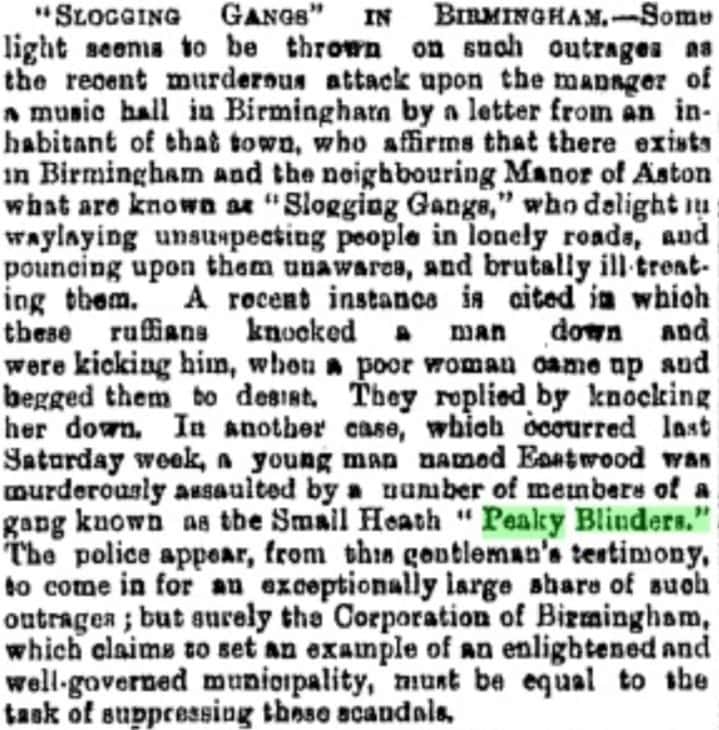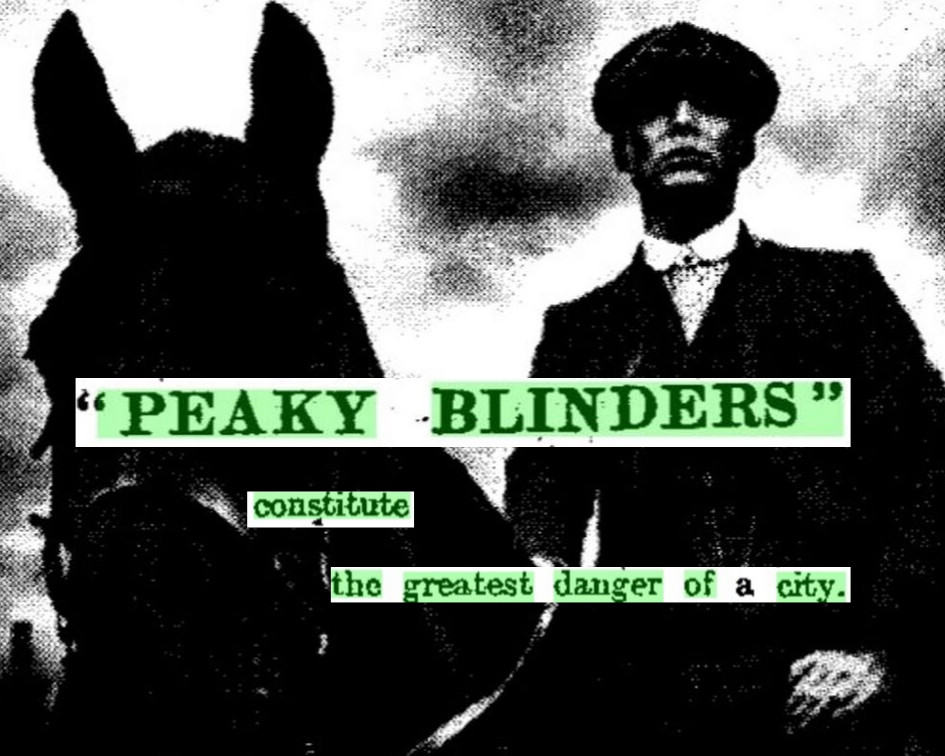│By Emily Priest, Gale Ambassador at the University of Portsmouth│
Since 2013, Peaky Blinders stormed the UK television charts. Five seasons and a well-deserved BAFTA later, the series continues to intrigue, outrage and fascinate viewers with its gritty, unflinching depiction of Birmingham gangs – the once very real “Peaky Blinders” gang in particular.
The show’s incredible acting and writing alone make it a pleasure to watch, yet I found I am also fascinated by, and interested to explore, its ability to revive the past for entertainment value. At first glance, the costumes and set appear authentic and true to the turn of the twentieth century, and the story seems feasible enough to be real – but how much is truly accurate? The gang itself was real, but what about the individual characters? The events we witness in the show? Using Gale’s primary source archives, I started to investigate these questions, and was surprised to discover how much was real and how much really wasn’t.
1. Thomas Didn’t Shoot Kimber
In my investigation I mainly focused on Gale’s Historical Newspaper databases which, when searched with the search term “Peaky Blinders”, provided results dating back to 1890. The first ever mention of the infamous Brummie gang in these archives is from the Aberdeen Journal.

This article writes that “there exists in Birmingham…what are known as “Slogging Gangs,” who delight in waylaying unsuspecting people in lonely roads…and brutally ill-treating them”. And later in the piece: “a young man named Eastwood was murderously assaulted by a number of members of a gang known as the Small Heath “Peaky Blinders””. The term “Slogging Gangs” isn’t used in the TV show but here seems to refer to the Peaky Blinders and probably their rival gangs as well. Although two gangs which feature heavily in in the show, the Sabinis and “Kimber’s Boys”, were real, they didn’t have the same level of rivalry with the Peaky Blinders that we see depicted on screen. In fact, the relationship between the Peaky Blinders and “Kimber’s Boys” – actually known as the Brummagem or Birmingham Boys – was completely different. In the TV show, the Peaky Blinders overthrow the Brummagem Boys and Thomas Shelby shoots Kimber. In reality it was the Birmingham Boys who won this conflict and ended the Peaky Blinders’ reign in 1910, nine years before the show is even set!

2. Razors Didn’t Exist Yet
Another key difference between the show and reality is the use of razor blades within gang members’ flat caps. Whilst these hats did become a symbol of the Peaky Blinders – “[they] derived their name”, John Marshall wrote in The Times, “from the habit of wearing peaked caps pulled well down over the eyes to avoid recognition” – they didn’t keep razors in them.
At the start of the Blinders’ reign in the 1890s, the razor blades featured in the show were non-existent in Birmingham. These replaceable razors were only introduced to the UK in 1908 when Gillette opened their first manufacturing factory. After this point, it would still be highly unlikely the Peaky Blinders used steel blades as at that time they were luxury items that working-class people couldn’t afford, as highlighted in Birmingham Live, the digital channel of the Birmingham Mail.
So, where did this myth come from? In 1929, the Daily Mail wrote that members had an “ingenious habit of wearing steel plates in the peaks of their caps, with which they playfully butted the eyes of their victims”. Unlike in the show where gang members slice the faces of their enemies with the razors in their caps, the real Peaky Blinders would headbutt their victims with steel enforced hats, dazing their opponent. It may be a small difference but shows that reality was arguably less gruesome than its fictional counterpart.

3. It Wasn’t Kept in the Family
In the same article from the Daily Mail we can also find familiar names such as ‘Albert’, ‘Thomas’ and ‘William’, however the name Shelby doesn’t appear in this, or any other reports from the time. Although inspiration for the show was taken from these individuals, it is safe to assume that the Shelbys were not in fact real people and that the gang operated on a larger, less intimate basis than family. In fact, in the Birmingham Daily Post found in Gale’s British Library Newspapers archive, there is mention of the existence of large numbers of gang members: “between twenty and thirty”. And in another newspaper, the Sheffield Evening Telegraph, there is mention of “between fifty roughs”.

4. They Were a Lot Younger Than Depicted
These gang members were also said to be a lot younger than their fictitious counterparts, being aged from “16 to 20”, rather than in their late twenties and thirties. One source from The Daily Mail in 1898 also labelled these gang members as teens. In it, the writer discusses the issue of “five-year attendance” whereby children were only required to be in school for five years, after which point many would cease their education. It was from this “five-year attendance class” of individuals “that the great “peaky-blinder” brigade and the bands of night ruffians… [were] recruited”.
5. They were by no means ‘heroes’
One thing that has always stood out to me about the TV show is its glorification of criminals. Whilst the show is gruesome and explicit, the characters are still presented as heroes and heroines (or, when ending up worse-off than their adversaries, as victims) yet in reality it appears they were brutal, out-of-hand thugs who didn’t act for reason or good. Indeed, The Sunderland Daily Echo and Shipping Gazette stated gang members would “stand at street corners to assault passers-by” and the Daily Mail said they “constitute the greatest danger of the city”.

Yet the show is correct about one thing – how often they got away with it!
…And a Truth: They Always Got Away With It
Despite the horrific crimes committed by both the real and fictitious Peaky Blinders, they ruled for twenty years and only a few members were sent to jail. As the editor of the Derbyshire Times and Chesterfield Herald writes, “the amount of crimes of the peaky blinders was terrible…eleven were tried out of about 50 cases”. In most instances, gang members were merely fined – as described in The Daily Mail in 1898 where a few individuals were fined “£4 each” for the serious crime of attacking a policeman.
It is fascinating to see the difference between the real and fictitious Peaky Blinders and with Gale’s primary source archives I was able to develop a new appreciation for the show, see the director’s creative decisions and learn more about the history of the country I was born in by asking questions and taking the time to enjoy research. Although I started my investigation with one interest in mind, I was soon immersed in exploring many other fascinating topics such as historic views on crime and punishment, the dynamics of industry, perceptions of education, the economy, politics and much more about society in nineteenth- and twentieth-century Britain.
And what’s even better is that Gale makes it possible to do all this from the comfort of my own home in just the TV ad breaks…!
Interested in reading more about the ‘Real’ Peaky Blinders? Check out this blog post.
Blog post cover image citation: Design created with an image from [Billen, Andrew. “The gangs of Old Birmingham.” Times. Times, 13 Sept. 2013, p. 11. The Times Digital Archive, https://link.gale.com/apps/doc/MIZGJP516606296/GDCS?u=webdemo&sid=GDCS&xid=597718c0] overlaid with text from[“Birmingham Hooligans.” Daily Mail, 15 Aug. 1898, p. 3. Daily Mail Historical Archive, 1896-2004, https://link.gale.com/apps/doc/EE1866027648/GDCS?u=uniportsmouth&sid=GDCS&xid=a1817d29] and [Corder, R. E. “The Seamy Side.” Daily Mail, 3 Apr. 1929, p. 8. Daily Mail Historical Archive, 1896-2004, https://link.gale.com/apps/doc/EE1865746004/GDCS?u=uniportsmouth&sid=GDCS&xid=f46b79eb]

